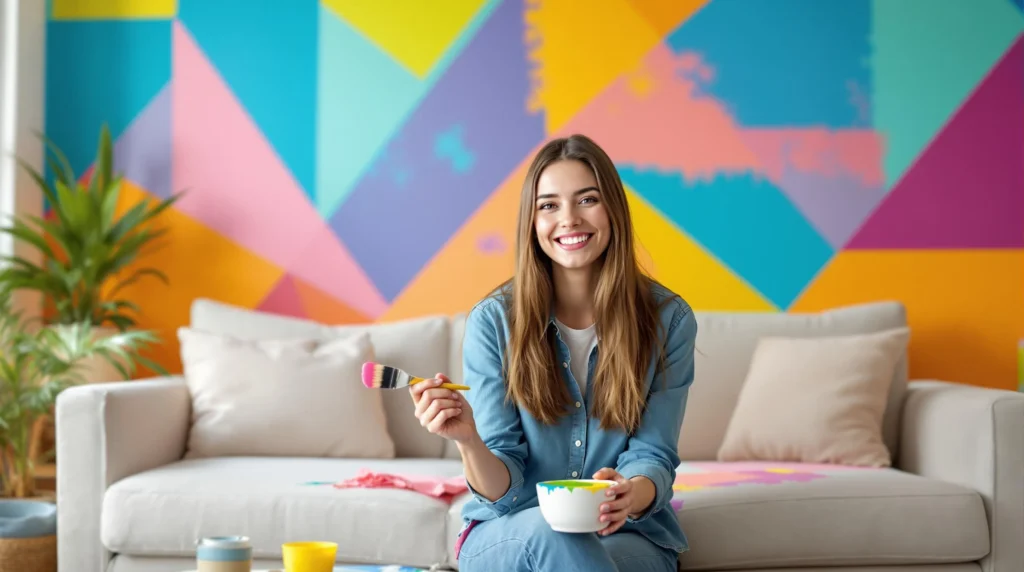Looking to transform a boring room into something spectacular? An accent wall might be just what you need! We’ve gathered some of the most unique accent wall ideas that’ll instantly elevate your space without requiring a complete renovation.
From geometric patterns and textured materials to unexpected color combinations, accent walls offer endless possibilities for personalization. They’re perfect for adding character to bedrooms, living rooms, home offices, or any space that needs a refresh. Whether you’re a DIY enthusiast or planning to hire a professional, we’ll show you how to make a stunning visual impact that reflects your personal style.
10 Breathtaking Unique Accent Wall Ideas to Transform Your Space
1. Geometric Wood Paneling
Geometric wood accent walls add depth and sophistication to any room. Using various wood strips arranged in patterns like herringbone, chevron, or diamond shapes creates visual interest while maintaining natural warmth. We recommend using different wood tones or stains to enhance the dimensional effect. This technique works beautifully in living rooms and dining areas where the texture becomes an instant conversation starter.
2. Bold Wallpaper Statements
Wallpaper has made a dramatic comeback with stunning designs that can transform a space instantly. Selecting a bold, large-scale pattern or vibrant color creates an eye-catching focal point without overwhelming the entire room. Many modern wallpapers are removable, making them perfect for renters or those who enjoy changing their décor frequently. Try botanical prints in bedrooms, abstract designs in offices, or vintage patterns in living spaces.
3. Color Block Painting
Color blocking involves using two or more distinct colors in bold geometric shapes on your wall. This approach allows for creative expression while maintaining a contemporary aesthetic. We love combining complementary colors for dramatic effect or using different shades of the same color for subtle sophistication. Painter’s tape is your best friend for creating clean, sharp lines between color sections.
4. Reclaimed Wood Installation
Reclaimed wood accent walls bring character and history to modern spaces. The weathered patina and varied textures of salvaged wood create depth while promoting sustainability. Each piece tells a story with its unique grain patterns, nail holes, and color variations. This rustic element pairs surprisingly well with contemporary furniture, creating a balanced design that feels both timeless and current.
5. 3D Textured Panels
Three-dimensional wall panels create dramatic shadows and texture that change throughout the day as lighting shifts. These panels come in various patterns from gentle waves to bold geometric designs. Installation is often straightforward with many panels designed to interlock or attach directly to existing walls. The monochromatic nature of these panels makes them versatile for any color scheme while still providing substantial visual impact.
6. Stone or Brick Veneer
Stone or brick veneers offer the character of natural materials without the structural requirements of full masonry walls. Modern manufacturing techniques have created lightweight, thin veneers that install easily on standard walls. Options range from rugged fieldstone to sleek slate or classic red brick. This treatment adds timeless texture that works in both traditional and contemporary settings.
7. Fabric Wall Treatments
Fabric-covered walls provide acoustic benefits while adding softness and warmth to a space. This technique involves stretching fabric over batting or foam and securing it to a wall for a cushioned effect. Velvet creates luxury, while linen offers casual elegance. The sound-dampening qualities make fabric walls particularly suitable for bedrooms, media rooms, or home offices where noise reduction enhances functionality.
8. Mural or Hand-Painted Design
Custom murals transform walls into artistic masterpieces that reflect personal style and interests. From abstract designs to nature scenes or geometric patterns, hand-painted walls offer unlimited customization. Working with a local artist can yield truly one-of-a-kind results customized to your space. Alternatively, DIY enthusiasts can use projectors to trace designs for more complex imagery.
9. Metal Accent Features
Metal elements bring industrial chic to residential spaces with their reflective qualities and structural presence. Copper, brass, steel, or aluminum sheets can be installed as full panels or cut into patterns for a more delicate effect. These materials develop beautiful patinas over time or can be maintained for continued shine. Metal accents work particularly well in kitchens, dining areas, or contemporary living spaces.
10. Living Walls with Vertical Gardens
Living walls bring nature indoors with stunning arrangements of plants growing vertically. These biophilic installations improve air quality while creating a ever-changing, evolving accent wall. Modern systems make maintenance manageable with built-in irrigation and modular planting pockets. The lush greenery provides a refreshing contrast to hard surfaces in the home while connecting interior spaces to the natural industry.
Using Bold Geometric Patterns for Visual Impact

Geometric accent walls have become a designer favorite for creating stunning focal points in any room. These versatile designs use angular shapes, contrasting colors, and 3D elements to transform ordinary spaces into visually striking environments.
How to Design Your Own Geometric Accent Wall
Creating your own geometric accent wall is easier than you might think with proper planning and execution. Start by sketching your design on paper, considering both scale and symmetry to ensure the pattern works proportionally with your wall dimensions. Using a projector or stencil can help transfer complex designs accurately onto your wall surface.
Measuring is critical to success. Map out your entire wall with a tape measure and level, marking key points where lines and shapes will intersect. We recommend triple-checking all dimensions before proceeding to avoid frustrating misalignments that could ruin the overall effect.
For materials, your design will dictate your choices. Three-dimensional effects require wood strips cut precisely to size, creating depth and shadow. Painted patterns need high-quality painter’s tape to section off areas cleanly. Popular geometric designs include hexagons, triangles, and asymmetric lines that pair beautifully with midcentury modern décor. Pinterest offers countless inspirations ranging from sophisticated monochromatic schemes to vibrant multi-colored layouts.
Best Paint Techniques for Geometric Patterns
Taping technique stands as the foundation for clean geometric patterns. Apply painter’s tape to outline your shapes, then paint carefully between the sections. Remember to remove the tape before the paint fully dries to ensure the crispest edges without bleeding.
Color-blocking creates dramatic visual impact when done right. Contrasting hues like navy and white deliver bold statements, while soft pastels offer more subtle distinction while still maintaining the geometric effect. Many designers are exploring unconventional color combinations to create truly unique accent walls.
Texture adds another dimension to geometric patterns. Combine matte and glossy finishes within the same color family to create subtle variations that catch the light differently throughout the day. Adding metallic accents to certain sections of your geometric design introduces reflection and shine that elevates the entire wall.
DIY geometric walls require just a few basic tools—primarily a level, tape measure, and painter’s tape—making them accessible even for beginners. Many detailed tutorials are available online for those new to home improvement projects, walking you through the process from concept to completion.
Incorporating Natural Materials for Texture and Warmth

Natural materials add authentic character and organic beauty to any interior space, creating a connection to the outdoors while providing visual interest. These elements transform ordinary rooms into inviting retreats through their inherent warmth and tactile qualities.
Reclaimed Wood Accent Wall Ideas
Reclaimed wood accent walls instantly add warmth and rustic charm to any room in your home. Salvaged from old barns, factories, or other structures, these weathered planks bring history and character through their unique patina, knots, and grain patterns. Installing reclaimed wood vertically elongates your space, while horizontal placement creates a cozy, cabin-like atmosphere perfect for bedrooms or living rooms.
For a modern twist, try creating geometric patterns with reclaimed wood pieces of varying colors and textures. Alternating light and dark wood tones generates visual interest and depth without overwhelming the space. In spaces craving texture, raw wood panels maintain their natural finish to showcase authentic grain patterns and irregularities that synthetic materials simply can’t replicate.
Shiplap offers another versatile wood option that works beautifully as an accent wall. Install shiplap boards horizontally for a traditional coastal look or vertically to create the illusion of higher ceilings. Painting shiplap in deep, moody colors adds sophisticated contrast while still maintaining textural interest through the characteristic gaps between boards.
Stone and Brick Installation Tips
Stone accent walls deliver timeless appeal and substantial texture to any interior space. Light-colored stones create an elegant, airy atmosphere in kitchens and entryways, while darker stones establish dramatic focal points perfect for living areas. Natural stone varies in color, texture, and pattern, ensuring your accent wall remains truly one-of-a-kind.
Brick accent walls infuse spaces with industrial character and architectural interest. These versatile materials work equally well in modern lofts and traditional homes. Temporary brick wallpaper offers an excellent alternative for renters or those hesitant about permanent installation, providing realistic texture without the commitment or weight of actual brick.
Proper installation ensures your stone or brick accent wall maintains its beauty for years. Always start with a clean, even surface free from dust and debris that could prevent proper adhesion. Apply manufacturer-recommended adhesives for your exact material type, working in small sections to maintain control and precision. Stone and brick veneer products significantly reduce weight concerns while delivering authentic appearance, making them suitable for most standard wall constructions without additional structural support.
Creating Dimension with 3D Wall Panels
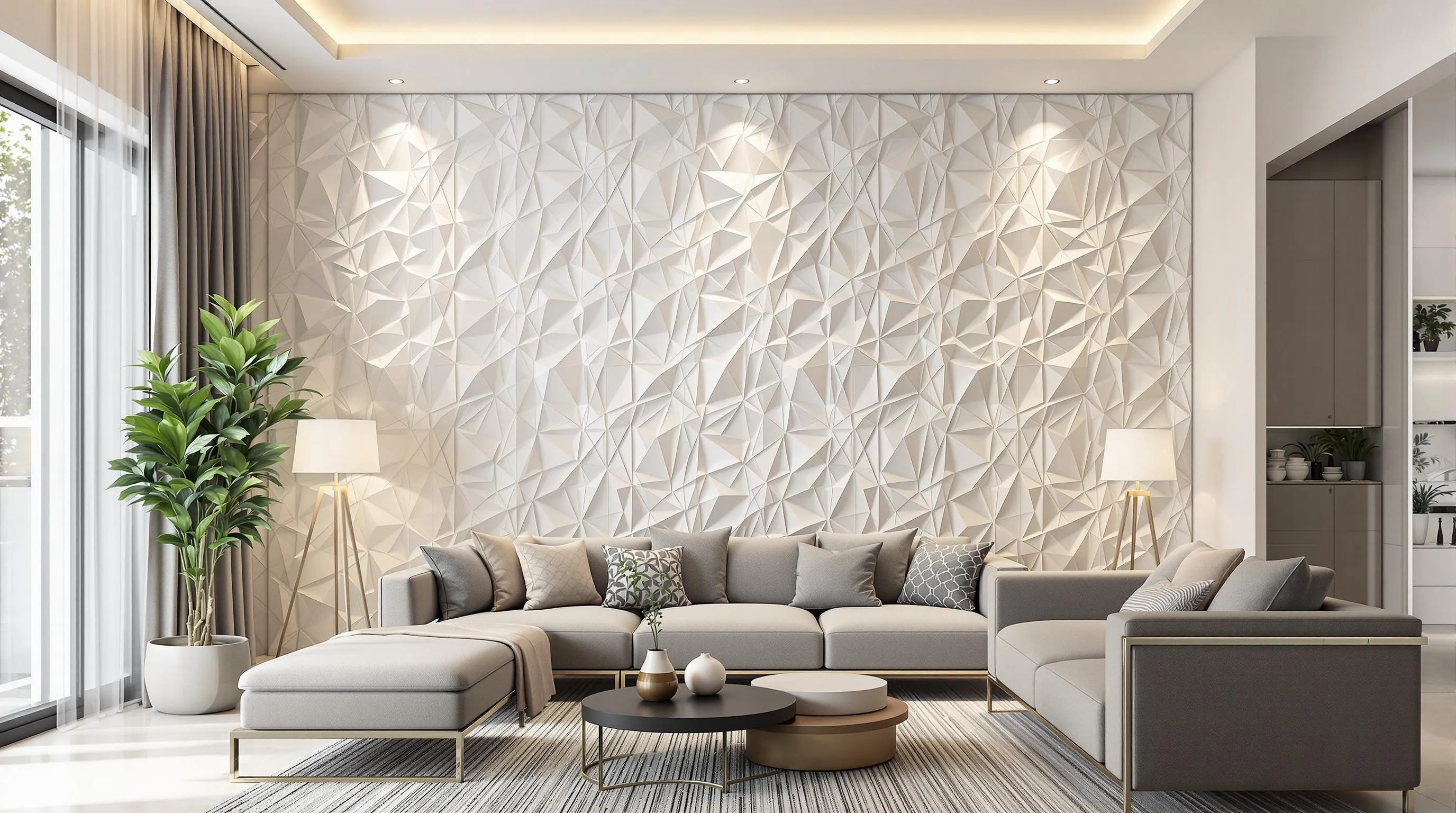
3D wall panels offer an innovative way to add texture and depth to your interior design, transforming flat surfaces into architectural focal points that capture attention. These dimensional elements create visual interest through shadow play and tactile appeal, making them perfect for modern accent walls.
Modern 3D Panel Options for Every Budget
Budget-conscious homeowners can explore peel-and-stick PVC or MDF panels, which typically cost under $5 per square foot and provide excellent answers for temporary spaces like rental properties. These affordable options don’t sacrifice style for price and can be easily removed when needed.
Mid-range budgets accommodate interlocking geometric PVC panels ranging from $10-$20 per square foot, featuring eye-catching honeycomb or hexagonal designs that create sophisticated visual patterns. These panels strike an ideal balance between quality and affordability for most homeowners.
Luxury spaces benefit from premium custom laser-cut wood or stone-look panels starting at $30 per square foot, delivering unmatched elegance and bespoke design possibilities. Materials vary widely, from lightweight PVC to substantial wood composites, with patterns spanning geometric precision, flowing wave forms, and delicate floral motifs to complement any design aesthetic.
DIY Installation Guide for 3D Wall Elements
Surface preparation forms the foundation of successful 3D panel installation, requiring thorough cleaning, crack filling, and sanding to ensure proper adhesion. Taking time with this initial step prevents future issues and guarantees a professional-looking finish.
Measurement demands precision, so use a level and pencil to mark your layout before beginning the installation process. This careful planning prevents misalignment issues that could compromise the visual impact of your dimensional wall.
Adhesive selection should match your panel type, with construction adhesive providing secure attachment for heavier panels while double-sided tape works perfectly for lightweight options. Always check manufacturer recommendations for exact adhesive requirements.
Panel placement works best when starting from a corner, pressing each piece firmly against the wall and working systematically across the surface. Trim edges cleanly with a utility knife as needed to fit the dimensions of your wall perfectly.
Finishing touches involve filling any visible seams with caulk and applying paint if desired to create a seamless, cohesive look. This final step transforms individual panels into a unified design statement that elevates your entire space.
Transforming Spaces with Stunning Wallpaper Designs
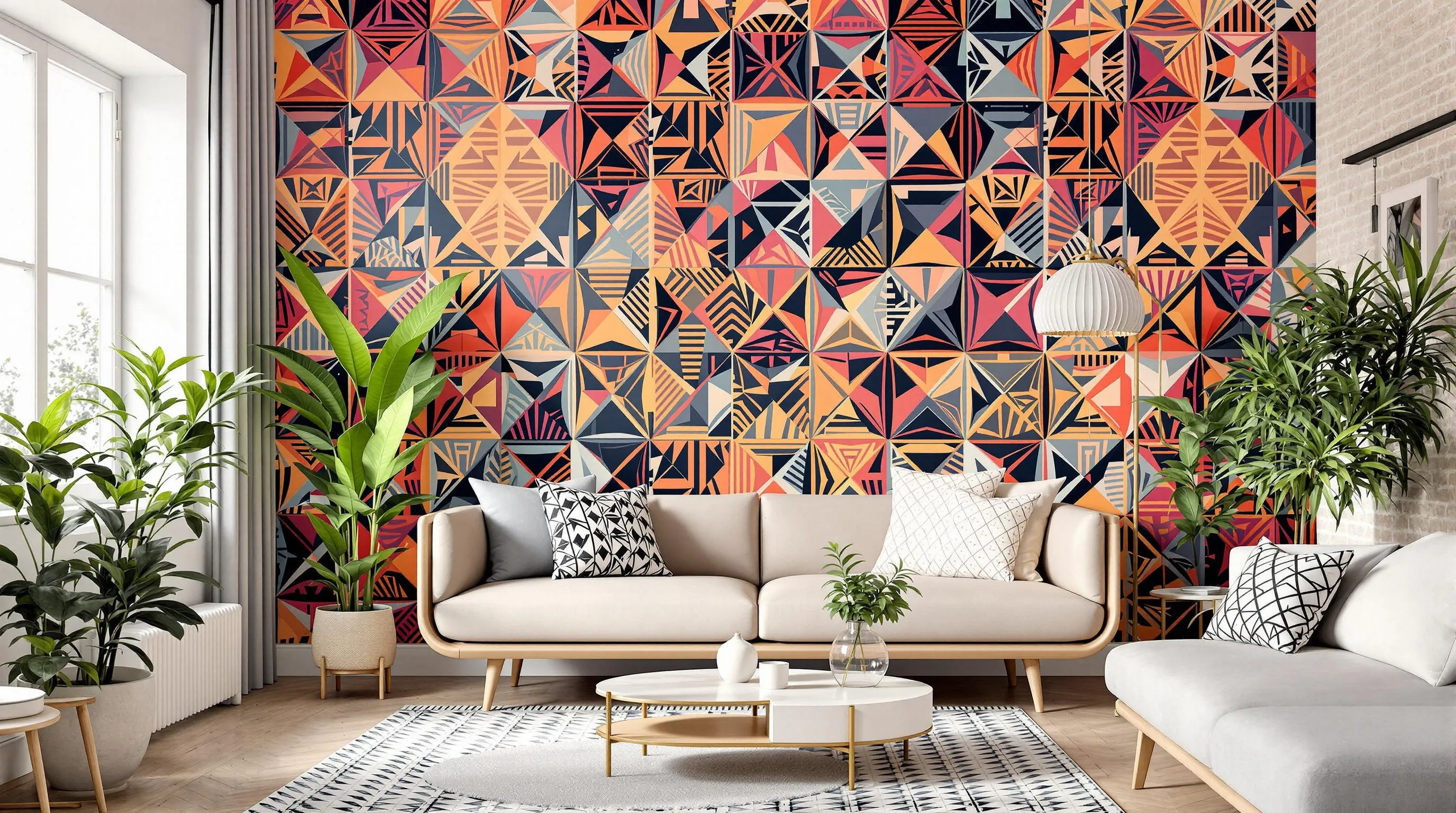
Wallpaper has made a remarkable comeback as one of the most versatile tools for creating captivating accent walls. Today’s designs offer unprecedented options to instantly transform any room with minimal effort and maximum impact.
Removable Wallpaper Options for Renters
Renters can now enjoy personalized spaces without sacrificing security deposits, thanks to temporary adhesive wallpaper answers. These peel-and-stick options feature diverse designs including botanical prints, faux textures like brick and wood, and minimalist line patterns that suit various aesthetic preferences. Installation requires no special tools or professional help, making it an ideal weekend project for anyone looking to refresh their space. Customizable murals in removable formats provide exceptional opportunities to create personalized accents in kids’ rooms or home offices, allowing tenants to express their style without permanent modifications. These affordable alternatives work well in bathrooms, kitchens, and bedrooms, giving renters the freedom to experiment with different looks throughout their lease term.
Statement Wallpaper Trends for 2025
Bold patterns and dramatic murals have emerged as dominant trends, with geometric shapes, abstract florals, and silhouette-based designs creating unforgettable focal points in contemporary homes. Dark and moody palettes featuring charcoal or navy create striking contrast in dining rooms and bedrooms, while vibrant hues like red and orange energize playrooms and creative spaces. Multidimensional wallpapers incorporating metallic finishes or textured layers add remarkable depth to living areas, elevating ordinary rooms into sophisticated environments. Functional designs now integrate shelving or lighting directly into accent walls, brilliantly blending décor with utility for space-conscious homeowners. Pastel tones offer subtle sophistication in primary bedrooms, balancing visual interest with the calming atmosphere essential for rest spaces. These innovative applications reflect 2025’s focus on multifunctional designs and adaptable materials that complement diverse living spaces.
Utilizing Creative Paint Techniques Beyond Solid Colors

Paint offers endless possibilities for creating stunning accent walls that go far beyond basic solid colors. With the right techniques, you can transform an ordinary wall into a captivating focal point that expresses your personal style.
Ombré and Gradient Wall Tutorials
Ombré accent walls create a smooth color transition that adds sophisticated dimension to any room. This technique involves blending two or more colors together, gradually shifting from one shade to another for a dreamy, watercolor-like effect. The beauty of ombré walls lies in their versatility—you can create vertical transitions for the illusion of higher ceilings or horizontal gradients for a wider-feeling space. Creating an ombré wall requires simple tools: several paint colors in the same family, a spray bottle with water, and blending brushes to achieve that seamless transition between colors. Many designers recommend working quickly while the paint remains wet, allowing colors to blend naturally where they meet for that perfect gradient effect.
Color-Blocking for Contemporary Spaces
Color-blocking delivers bold visual impact by using multiple distinct colors side by side in geometric configurations. This technique instantly modernizes any room with sharp lines and creative color combinations that reflect contemporary design sensibilities. The effectiveness of color-blocking comes from its ability to create clearly defined sections that can highlight architectural features or establish zones within open-concept spaces. Achieving perfect color-blocks requires precise planning and careful taping to ensure clean lines between different colored sections. Design professionals often suggest limiting your palette to three complementary colors for balanced visual interest without overwhelming the space. For maximum impact, consider unexpected color pairings that create ever-changing tension while still harmonizing with your existing décor elements.
Designing Gallery Walls with Personality
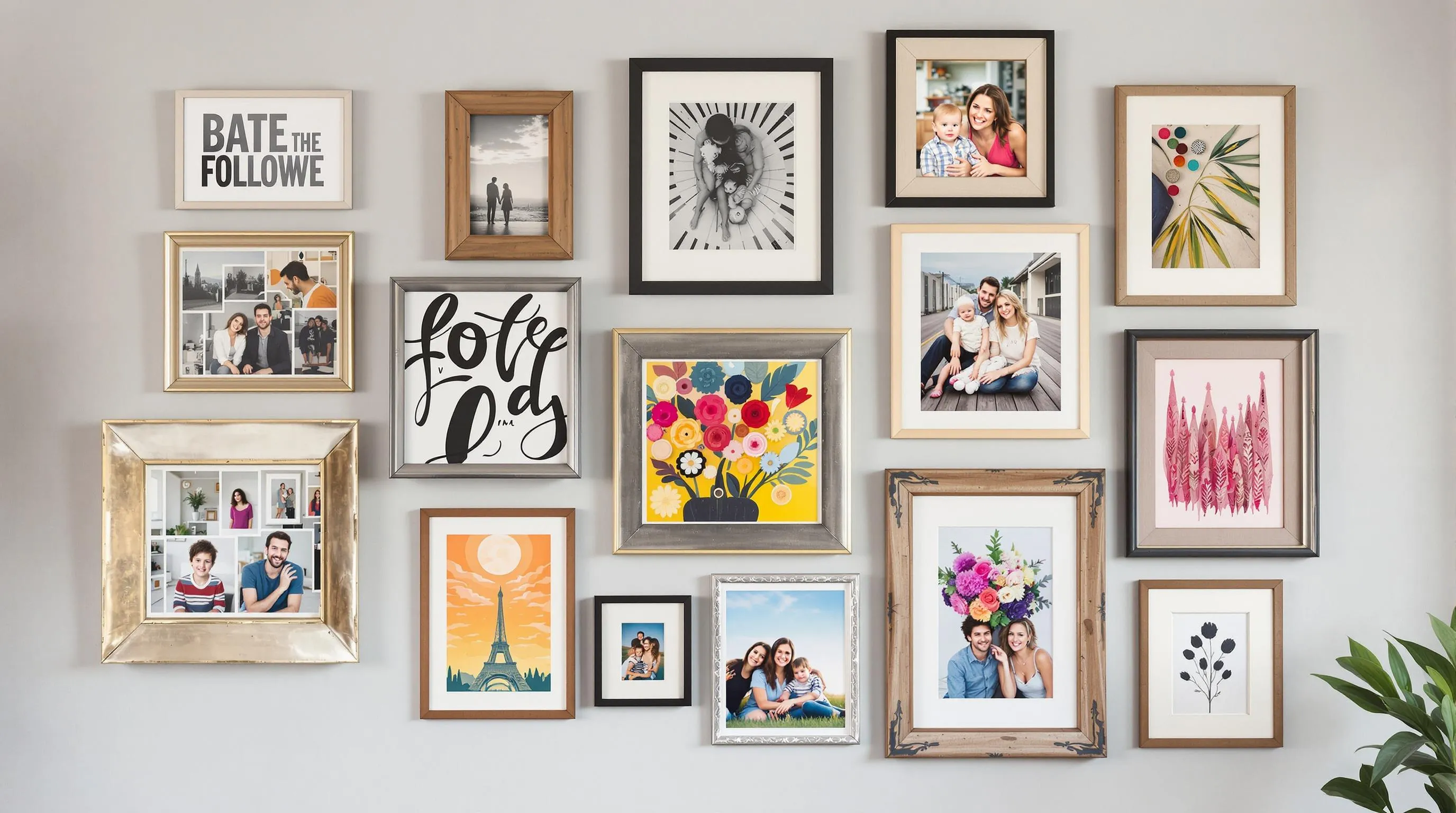
Gallery walls offer a perfect opportunity to transform an accent wall into a personalized showcase of your style and memories. Creating an eye-catching display requires thoughtful curation and arrangement to achieve a cohesive yet ever-changing look.
Curating Art for a Cohesive Gallery Wall
Selecting artwork that shares a common theme or color palette creates visual harmony while allowing for personal expression. Start by gathering pieces that resonate with you—family photos, prints, paintings, or even textile art—ensuring they connect through consistent elements. Consider maintaining a unified color scheme throughout your selections to tie different pieces together visually. For example, black and white photography collections create elegant consistency, while artwork featuring complementary colors can establish a sophisticated palette. Remember that variety in size and subject matter adds interest, but the connecting thread of similar tones or themes will maintain the wall’s cohesive appearance.
Unique Framing Options and Arrangements
Mixing frame styles and sizes adds depth and visual interest to your gallery wall while showcasing your distinctive taste. Try combining modern thin metal frames with vintage wooden ones for an eclectic yet balanced look. Varying matting sizes and colors can further enhance your display, drawing attention to exact pieces while maintaining overall harmony. Before committing to nail holes, experiment with different layouts by arranging your framed pieces on the floor first. This practice allows you to visualize the finished wall and make adjustments easily. Popular arrangements include grid patterns for formal spaces, salon-style for artistic expression, and asymmetrical designs for contemporary flair. Leave consistent spacing between frames (typically 2-3 inches) to create a polished look that lets each piece breathe while forming a collective visual statement.
Installing Unexpected Materials for Conversation Starters

Looking to create a truly unique accent wall that gets people talking? Unexpected materials can transform an ordinary wall into an extraordinary focal point that showcases your personal style. From industrial elements to luxurious textures, these innovative options offer both visual impact and practical benefits.
Faux Brick or Stone Accent Walls
Faux brick or stone offers versatility without the commitment of permanent construction. Temporary wallpaper that mimics textured materials provides an affordable option for renters or those who like to change their décor frequently. For a more lasting impact, 3D panels or authentic stone create stately focal points that work beautifully in kitchens or entryways, adding architectural interest and timeless appeal.
Reclaimed Wood Applications
Reclaimed wood installations introduce warmth and character to any space. Raw wood or shiplap can be installed vertically or horizontally to create different visual effects and match your design aesthetic. Custom designs using thin materials like luon cut to size offer flexibility for creating modern or rustic looks that highlight the natural beauty of wood grain patterns.
Industrial Metal Finishes
Aluminum and non-traditional metals bring an industrial edge to contemporary spaces. Metallic finishes can reflect light and add dimension, making rooms appear larger and more ever-changing. Perforated aluminum panels introduce interesting patterns while maintaining a sleek, modern vibe that works particularly well in living spaces or home offices with minimalist décor.
Functional Millwork Designs
Custom cabinetry or built-in shelving integrated into accent walls serves the dual purpose of storage and design enhancement. These functional elements can be finished with faux treatments like copper or bronze to elevate their appearance. Millwork adds depth and practicality to your accent wall while creating a custom look that addresses your exact storage needs.
Metal Accent Wall Inspiration
Perforated metal panels create stunning accent walls that allow for light diffusion and geometric interest. These versatile materials complement mid-century or contemporary design schemes while adding industrial sophistication. Faux copper or bronze applications using metallic paints or thin veneers deliver luxury accents without the cost of solid metal installations. These treatments look particularly striking when paired with strategic ambient lighting that highlights their reflective properties and brings warmth to the metallic finish.
Fabric and Upholstered Wall Treatments
Textured textiles transform walls into soft, tactile features that enhance both aesthetics and acoustics. Velvet, burlap, or woven fabrics stretched over frames add dimension and comfort to bedrooms or home theaters, effectively dampening sound while creating visual interest. Tufted panels featuring diamond-buttoned upholstery in bold colors or sophisticated neutrals introduce classic elegance to formal dining rooms or master bedrooms.
Temporary fabric installations offer flexibility for renters or those who enjoy seasonal décor changes. Lightweight fabrics secured with tension rods or adhesive strips enable easy updates without damaging walls. These non-permanent answers allow for creative expression without the commitment, making them ideal for apartments or frequently redesigned spaces.
Incorporating Lighting Elements into Accent Walls

Lighting can transform an ordinary accent wall into a spectacular focal point that changes the entire mood of your space. By integrating illumination directly into your accent wall design, you’ll create depth, dimension, and drama that static walls simply can’t achieve.
LED Strip and Backlit Panel Ideas
LED strip lighting offers incredible versatility for accent walls, allowing you to frame edges or highlight exact areas with a customizable glow. Color-changing LED strips provide even more flexibility, letting you adjust the ambiance to match different moods or occasions with just a touch of a button. These ever-changing strips can outline architectural features, create floating effects behind furniture, or emphasize textural elements on your accent wall.
Patterned backlit panels take illuminated walls to the next level by combining physical texture with light for truly stunning results. These panels feature unique cutouts, textures, or translucent sections that create captivating shadow play when illuminated from behind. Glass or acrylic inserts work particularly well in modern spaces, diffusing light evenly while adding sophisticated depth. The combination of pattern and illumination creates a constantly changing visual experience as ambient light conditions shift throughout the day.
Statement Light Fixtures for Wall Enhancement
Sconces and wall lamps serve dual purposes on accent walls, functioning as both decorative elements and targeted light sources. Strategic placement of these fixtures can highlight textural details, create interesting shadow patterns, or draw attention to exact areas of your feature wall. Contemporary sconces with unusual shapes or materials can become artistic statements themselves, complementing your overall wall design.
LED tape installation presents endless creative possibilities for accent walls, allowing you to outline custom patterns or geometric shapes directly on the wall surface. This technique brings flat designs to life with a subtle glow that appears to float on the wall. The flexible nature of LED tape makes it ideal for creating curves, angles, or even writing words that illuminate your space with personal meaning.
Illuminated art takes wall lighting to new heights by focusing light directly on wall-mounted pieces. Adjustable picture lights can highlight paintings or photographs, while custom LED frames can surround digital art or special prints. This targeted illumination technique transforms ordinary artwork into dramatic focal points that command attention in any room, especially when installed on an already distinctive accent wall.
Using Mirrors and Reflective Surfaces for Visual Expansion
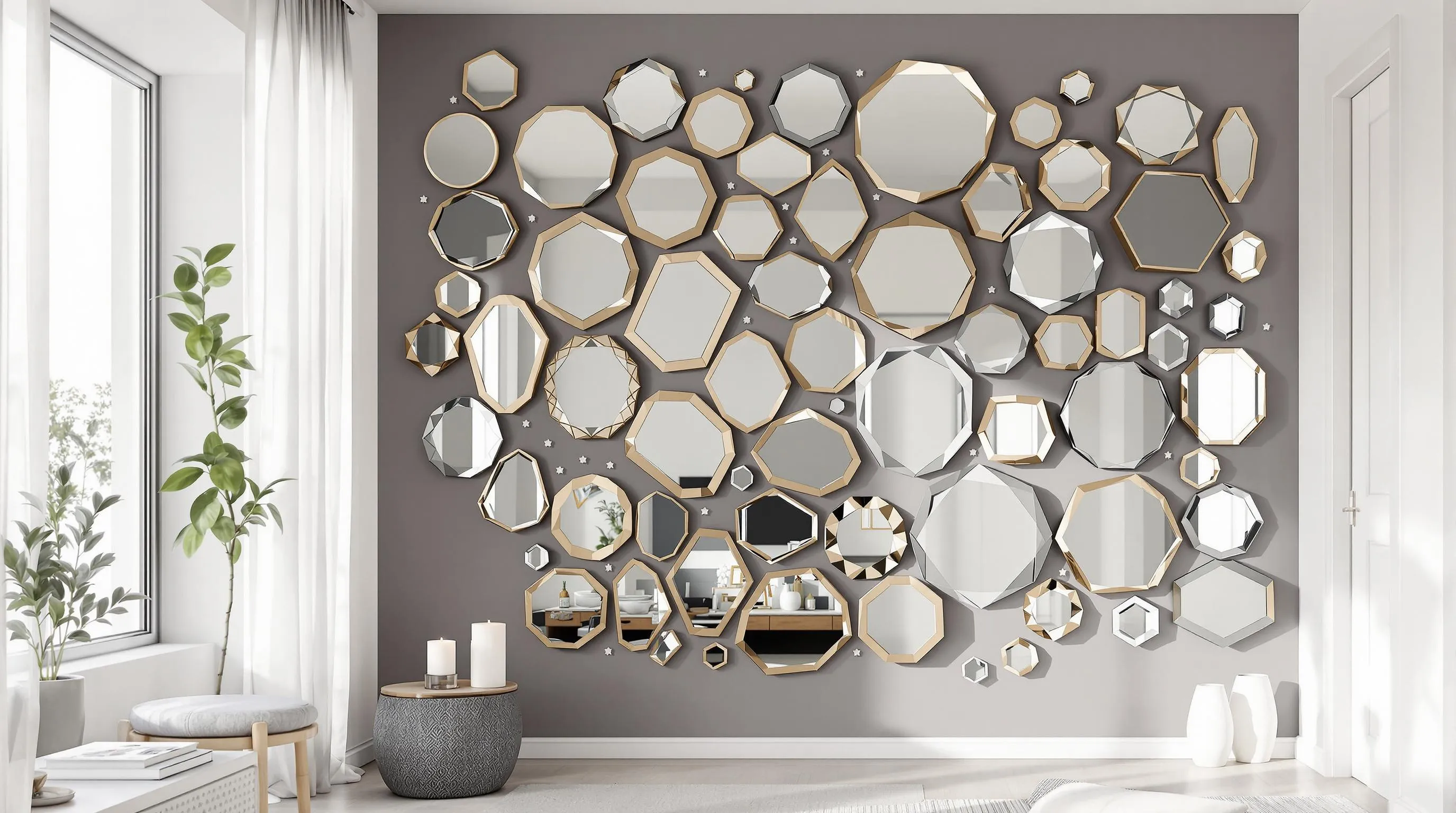
Mirrors and reflective surfaces create one of the most functional and visually stunning accent wall options available today. They not only serve as decorative elements but also strategically expand spaces by reflecting light and creating an illusion of depth.
Mirror Arrangement Techniques for Maximum Impact
Creating a mirror accent wall requires thoughtful arrangement to achieve the desired visual effect. Strategic placement of mirrors can dramatically transform a cramped room into one that feels spacious and airy. Full-wall mirror installations work wonderfully in smaller spaces like entryways or narrow hallways, instantly doubling the perceived space. Alternatively, arranging multiple mirrors in a gallery-style configuration adds artistic flair while maintaining the space-expanding benefits. For a modern approach, consider installing mirrors in geometric patterns with small gaps between each piece, creating a sophisticated and custom look. Mirrors positioned opposite windows capture natural light and bounce it throughout the room, brightening dark corners and improving the overall ambiance. Framed mirrors in various sizes and complementary styles can be grouped together to create a cohesive yet ever-changing wall display that reflects your personal style while making the room appear larger.
Mirrored Tile Installation Guide
Installing mirrored tiles transforms an ordinary wall into a stunning reflective surface with relatively simple techniques. Begin by measuring your wall space carefully and purchasing 10-15% more tiles than calculated to account for cuts and potential breakage. Thoroughly clean and prepare your wall surface, ensuring it’s smooth, dry, and free of dust or debris that could prevent proper adhesion. Apply construction adhesive specifically designed for mirror installation in a zigzag pattern on the back of each tile, avoiding the edges to prevent seepage. Position tiles in your desired pattern—grid formations create a classic look while herringbone or diamond arrangements offer more visual interest. Maintain consistent spacing between tiles using plastic spacers for a professional finish. After placing each tile, press firmly for 30 seconds to ensure proper adhesion to the wall surface. For cutting mirrored tiles, use a glass cutter with a straight edge guide and score once with confident pressure before carefully snapping along the scored line. After installation, allow at least 24 hours for the adhesive to cure completely before cleaning the mirrored surface with a non-ammonia glass cleaner to maintain its reflective properties.
Bringing Nature Indoors with Living Accent Walls
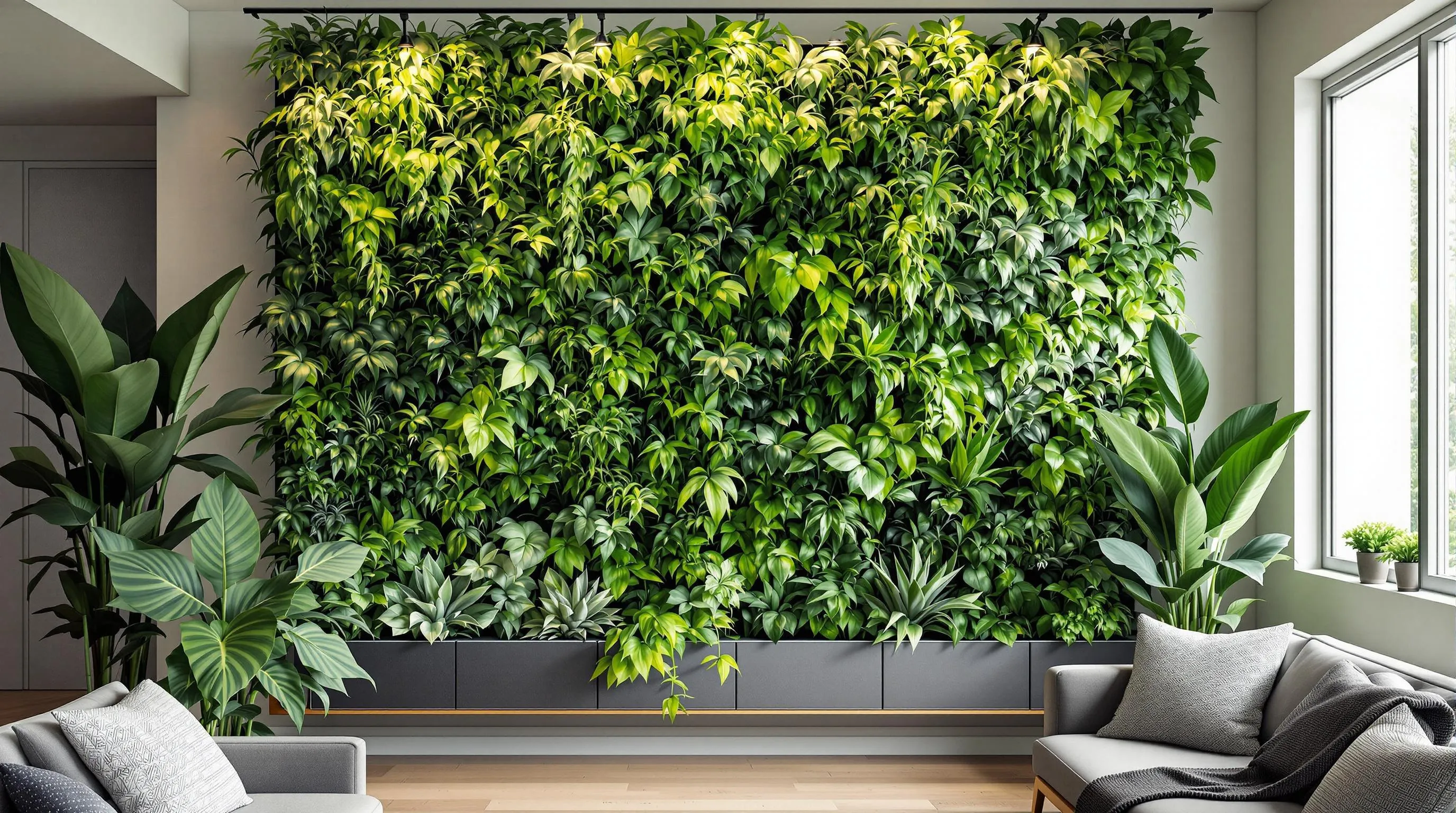
Living accent walls merge nature with interior design, creating stunning organic focal points that transform spaces with vibrant greenery. These vertical gardens introduce texture, color, and even improved air quality while serving as conversation-starting design elements in any room.
Low-Maintenance Plant Wall Options
Faux greenery panels offer a maintenance-free approach to plant walls, with pre-assembled artificial options that perfectly replicate tropical foliage or moss textures without requiring watering or sunlight. Many Etsy sellers specialize in customizable designs that can be customized to complement your existing décor while delivering the visual benefits of greenery. Preserved moss walls provide another excellent alternative, featuring chemically treated moss that retains its natural color and soft texture—ideal for humidity-controlled interior spaces where you want organic appeal without ongoing care. For those willing to do minimal maintenance, succulent frameworks incorporating drought-resistant plants in modular planters reduce watering frequency to just once every two weeks, making them perfect for busy homeowners who still want living elements in their design.
Vertical Garden Installation Basics
Structure serves as the foundation for any successful living wall, with options including wall-mounted grids, pocket planters, or modular tile systems—all requiring waterproof backing to protect your underlying wall from moisture damage. Irrigation becomes crucial for live plant installations, where integrated drip systems with timers or self-watering reservoirs ensure consistent moisture levels without daily attention. Plant selection should prioritize air-purifying species like snake plants and spider plants, which not only look beautiful but actively improve indoor air quality by removing toxins. Maintenance requirements vary based on your chosen system, with most living walls needing monthly trimming to control overgrowth and regular monitoring for pests, while choosing low-light species can significantly reduce additional lighting costs and complexity. Benjamin Moore’s organic-inspired greens like Fernwood Green 2145-40 complement these installations perfectly, creating a cohesive color story that enhances the natural aesthetic of your living accent wall.
Conclusion: Choosing the Right Accent Wall for Your Space
Transforming your space with an accent wall is one of the most impactful ways to refresh your home’s look without a complete renovation. Whether you’re drawn to bold geometric patterns natural materials 3D textures or living walls the perfect accent wall can express your personality while creating a stunning focal point.
Remember that lighting placement and your room’s existing elements all play crucial roles in determining which accent wall will work best. Don’t be afraid to experiment with unexpected materials or temporary answers if you’re renting.
We hope these ideas have inspired you to take that bold step toward creating a space that truly feels like your own. With some planning creativity and the right techniques your accent wall will transform an ordinary room into something extraordinary.
Frequently Asked Questions
What is an accent wall and why should I create one?
An accent wall is a single wall in a room that stands out through color, texture, or design. Creating one adds visual interest and personality to your space without the commitment of renovating the entire room. It’s an affordable way to transform a dull area into a stunning focal point that reflects your style while adding depth and character to your home.
How do I choose which wall should be my accent wall?
Select a wall that naturally draws attention when entering the room—typically the wall behind a bed, sofa, or desk. Avoid walls with too many doors or windows. The ideal accent wall should be architecturally interesting or frame an important furniture piece. Consider your room’s layout and choose a wall that will enhance, not overwhelm, your existing décor.
Can I create an accent wall in a small room?
Absolutely! An accent wall can actually make a small room feel larger when done correctly. Choose lighter colors or reflective materials to create depth, or use vertical patterns to give the illusion of height. Mirrors make excellent accent walls in small spaces as they reflect light and visually expand the area. Just avoid overly busy patterns that might make the space feel cluttered.
What are some budget-friendly accent wall ideas?
Paint is the most affordable option—try color blocking or geometric patterns using painter’s tape. Removable wallpaper works well for renters. Reclaimed wood pallets can be repurposed for rustic charm. Create a gallery wall with personal photos in coordinated frames. Fabric can be attached to walls using liquid starch for a temporary solution. Even creatively arranged washi tape can make a striking geometric design.
How difficult is it to install a geometric wood accent wall?
Installing a geometric wood accent wall requires intermediate DIY skills. You’ll need basic tools like a saw, level, nail gun, and measuring tape. The complexity comes from precise measurements and cuts needed for clean geometric patterns. Allow 1-2 weekends for completion. For beginners, start with simpler patterns or consider hiring a professional for complex designs to ensure a polished result.
Are 3D wall panels difficult to install?
3D wall panels are surprisingly DIY-friendly. Most panels come with interlocking systems or can be installed using construction adhesive and finishing nails. Proper surface preparation is crucial—walls should be clean, dry, and smooth. Accurate measuring and cutting are important for a seamless look. The average installation takes a weekend, depending on room size. Many panels can be painted to match your décor.
How can I create an accent wall if I’m renting?
Removable wallpaper, peel-and-stick wood panels, and fabric wall treatments are perfect for renters. Temporary brick or tile decals create texture without damage. Command strips can mount lightweight panels or create a gallery wall. Washi tape geometric patterns offer creative expression without paint. Large tapestries or framed fabric panels can be hung like artwork. All these options remove cleanly without affecting your security deposit.
What lighting elements work best with accent walls?
LED strip lights behind 3D panels create dramatic shadows and depth. Wall sconces or picture lights can highlight textured materials or artwork. For painted accent walls, directional track lighting enhances color vibrancy. Backlit panels add ambient glow to translucent materials. Consider dimmable options to adjust the mood. The right lighting transforms your accent wall from impressive to extraordinary by emphasizing its unique features.
How do I maintain a living plant accent wall?
Choose appropriate plants for your light conditions and install a proper irrigation system—either self-watering or manual. For easy maintenance, select hardy varieties like pothos, ferns, or succulents. Establish a regular feeding and pruning schedule. Monitor for pests weekly. Alternatively, preserved moss walls require no watering while still providing biophilic benefits. For the lowest maintenance, high-quality artificial plant panels offer the look without the care.
Can accent walls work with any interior design style?
Yes, accent walls are versatile enough for any design style when materials and colors are chosen thoughtfully. For minimalist spaces, try subtle textured panels or tone-on-tone patterns. Traditional homes benefit from elegant wallpaper or classic wainscoting. Industrial styles pair well with metal, concrete, or exposed brick. Modern interiors can feature bold geometric patterns or high-contrast colors. The key is selecting elements that complement your existing design language.

